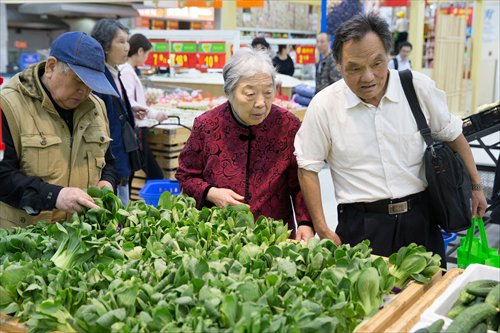Reforms, consumption set to boost growth

Consumers buy vegetables at a supermarket in Nanjing, East China's Jiangsu Province. Photo: CFP
The current slowdown in the Chinese economy can be eased through supply-side reforms and using stimulus policies to boost domestic consumption, and China is currently taking these measures, analysts noted Thursday.
The comments came amid a new round of discussion about how the Chinese government should tackle the economic slowdown.
The Wall Street Journal on Wednesday described an earlier article in People's Daily, the flagship newspaper of the Communist Party of China, as "an implicit criticism of recent stimulus-fueled economic policy."
The People's Daily article, which was published on Monday, quoted an "authoritative figure" as saying that China needs to focus more on cutting inventories, paring excess capacity and reducing debt.
Analysts noted that supply-side reforms and stimulus policies are both necessary for the economy and are not contradictory.
"Supply-side reform is a long lasting process, while stimulus-fueled economic policy is used to boost demand when the country encounters short-term economic difficulties," Huang Song, associate professor at the Financial & Industrial Development Institute of Peking University, told the Global Times Thursday.
"They are different, but not contradictory," Huang said.
The country will cut leverage in the economy in various ways, including allowing bankruptcies, and will not resort to large-scale stimulus, vice premier Zhang Gaoli told a forum Wednesday in Beijing.
Downward pressure
Amid continuing economic headwinds, the benchmark Shanghai Composite Index declined 0.04 percent on Thursday to close at 2,835.86 points.
"The country's economy is facing downward pressure during the process of structural transformation, as cutting inventories and reducing leverage bring many challenges," Liu Xuezhi, a macroeconomist at Bank of Communications, told the Global Times on Thursday.
Also, the country's currency is facing depreciation pressure, given the sluggish world economic context, said Tian Yun, director of the China Society of Macroeconomics Research Center.
"The world economic recovery is weak and there are uncertainties, leading to fluctuations in the domestic capital market," Liu noted.
In a bid to deal with the current difficulties, the country is expected to implement a stabilized currency policy, which should be neither too tight nor too loose, experts noted.
"The country should also continue to expand consumer spending via some measures such as structural tax cuts," Liu said.
Domestic demand is quite stable at the moment and still has substantial room for growth, Liu said, noting that finding ways to boost consumption will play a vital role in advancing growth.
The National Development and Reform Commission (NDRC), the country's top economic planner, and other authorities are stepping up efforts to increase domestic consumption to drive the transition and upgrading of the economy, Zhao Chenxin, spokesperson for the NDRC, told a briefing Thursday in Beijing.
"Government policies should focus on supply-side reforms to promote domestic consumption, trying to create supply that can help economic growth and tackle overcapacity effectively," Liu said.
Tian agreed, saying that the authorities should focus on how to find new work for people who lose their jobs during the process of cutting overcapacity.
There should be tax cuts for companies that agree to employ those people, Tian told the Global Times Thursday.
New growth drivers
Although challenges remain, there have been some positive economic signs recently.
China's industrial profits rose 7.4 percent year-on-year in the first quarter of 2016, and the Consumer Price Index, the main measure of inflation, rose 2.3 percent year-on-year in April, the third consecutive month it increased more than 2 percent, according to the latest data from the National Bureau of Statistics (NBS).
China has set a target of GDP growth of 6.5 to 7 percent in 2016, after growth dropped to a 25-year low of 6.9 percent in 2015. GDP growth in the first quarter this year reached 6.7 percent.
Data for the first quarter appears to show that the downward pressure has eased, thanks to government policies to stabilize the economy and the rise of sectors that are driving growth, Liu noted.
"Economic growth tends to be stable but given the pressure brought by tackling overcapacity, a return to rapid growth seems unlikely and slight fluctuations are still possible," he said.
Some sectors such as high technology and services have seen rapid growth in recent years and will be major drivers for economic growth in the future, experts noted.
For instance, domestic smartphone makers such as Xiaomi and Huawei are competing strongly with foreign brands, Tian said.